The NVIDIA GeForce GTX 750 Ti and GTX 750 Review: Maxwell Makes Its Move
by Ryan Smith & Ganesh T S on February 18, 2014 9:00 AM ESTPower, Temperature, & Noise
As always, last but not least is our look at power, temperature, and noise. Next to price and performance of course, these are some of the most important aspects of a GPU, due in large part to the impact of noise. All things considered, a loud card is undesirable unless there’s a sufficiently good reason – or sufficiently good performance – to ignore the noise.
| GeForce GTX 750 Series Voltages | ||||
| Ref GTX 750 Ti Boost Voltage | Zotac GTX 750 Ti Boost Voltage | Zotac GTX 750 Boost Voltage | ||
| 1.168v | 1.137v | 1.187v | ||
For those of you keeping track of voltages, you’ll find that the voltages for GM107 as used on the GTX 750 series is not significantly different from the voltages used on GK107. Since we’re looking at a chip that’s built on the same 28nm process as GK107, the voltages needed to drive it to hit the desired frequencies have not changed.
| GeForce GTX 750 Series Average Clockspeeds | |||||
| Ref GTX 750 Ti | Zotac GTX 750 Ti | Zotac GTX 750 | |||
| Max Boost Clock |
1150MHz
|
1175MHz
|
1162MHz
|
||
| Metro: LL |
1150MHz
|
1172MHz
|
1162MHz
|
||
| CoH2 |
1148MHz
|
1172MHz
|
1162MHz
|
||
| Bioshock |
1150MHz
|
1175MHz
|
1162MHz
|
||
| Battlefield 4 |
1150MHz
|
1175MHz
|
1162MHz
|
||
| Crysis 3 |
1149MHz
|
1174MHz
|
1162MHz
|
||
| Crysis: Warhead |
1150MHz
|
1175MHz
|
1162MHz
|
||
| TW: Rome 2 |
1150MHz
|
1175MHz
|
1162MHz
|
||
| Hitman |
1150MHz
|
1175MHz
|
1162MHz
|
||
| GRID 2 |
1150MHz
|
1175MHz
|
1162MHz
|
||
| Furmark |
1006MHz
|
1032MHz
|
1084MHz
|
||
Looking at average clockspeeds, we can see that our cards are essentially free to run at their maximum boost bins, well above their base clockspeed or even their official boost clockspeed. Because these cards operate at such a low TDP cooling is rendered a non-factor in our testbed setup, with all of these cards easily staying in the 60C or lower range, well below the 80C thermal throttle point that GPU Boost 2.0 uses.
As such they are limited only by TDP, which as we can see does make itself felt, but is not a meaningful limitation. Both GTX 750 Ti cards become TDP limited at times while gaming, but only for a refresh period or two, pulling the averages down just slightly. The Zotac GTX 750 on the other hand has no such problem (the power savings of losing an SMX), so it stays at 1162MHz throughout the entire run.

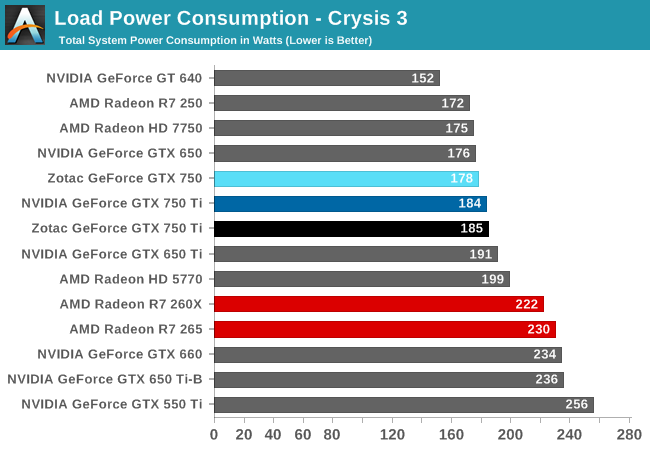
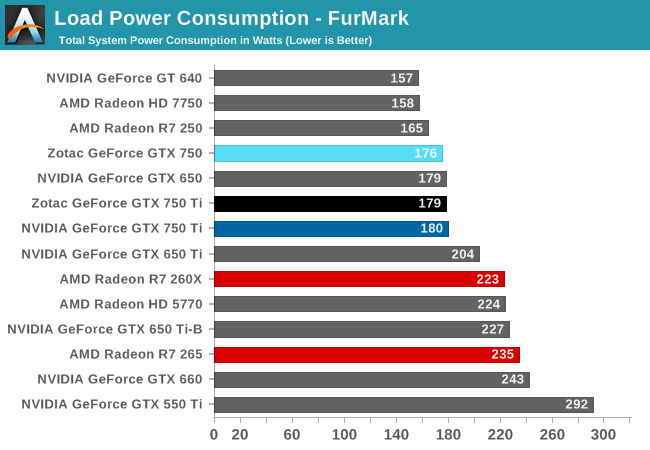


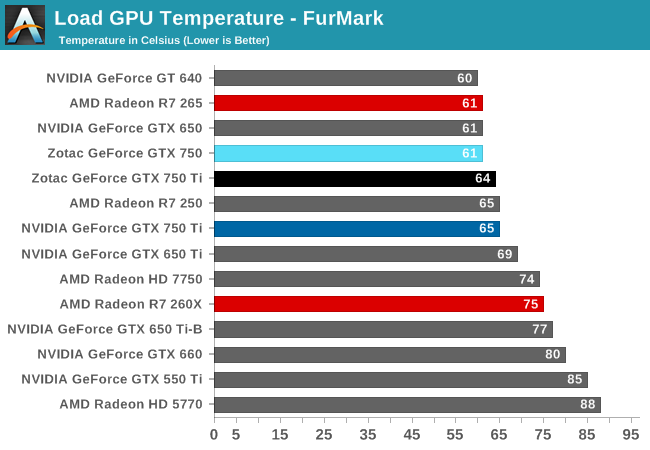
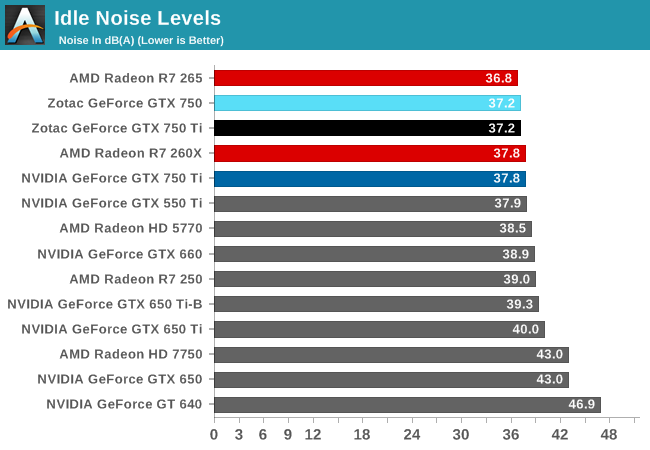
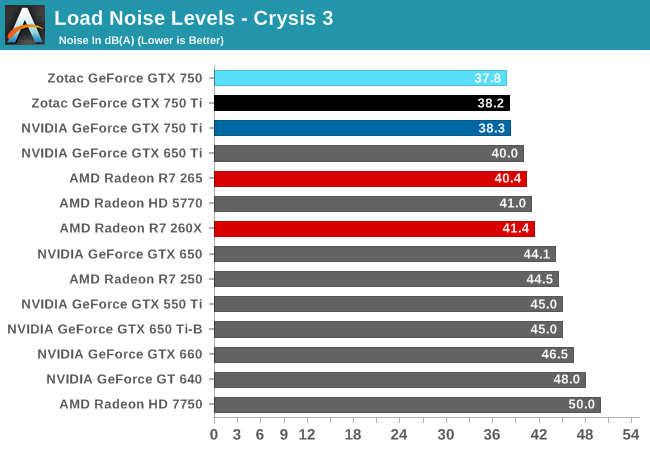
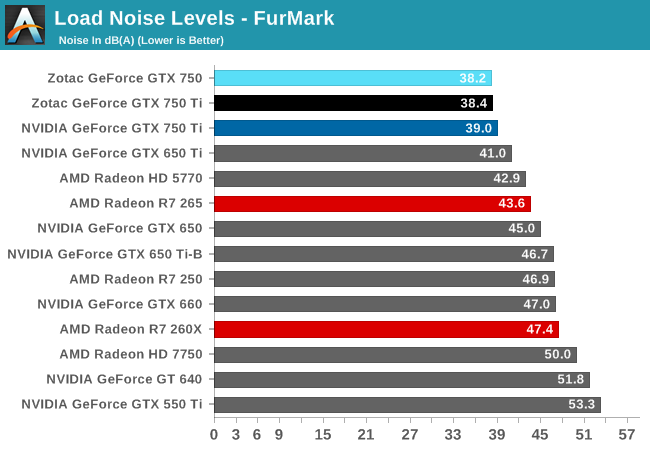










177 Comments
View All Comments
Harag - Thursday, March 6, 2014 - link
Not true at all. The release of the Titan showed they could unlock FP64 performance on a specific architecture. The Titan Black also has amazing FP64 performance. You may also want to look into their Quadro line.kwrzesien - Tuesday, February 18, 2014 - link
Cards are available on Newegg! Check out this EVGA Superclocked (1268MHz) with a dual-fan ACX cooler and 6-pin PCIe power connector: http://www.newegg.com/Product/Product.aspx?Item=N8...Frenetic Pony - Tuesday, February 18, 2014 - link
Maxwell is designed for mobile gaming, in which case who cares? Broadwell looks to improve performance per watt at least as much as Maxwell if Intel's initial hints of 30% power improvement for 14nm and 40% improvement for gpu power efficiency pan out. And they were already damned good.But Maxwell isn't designed for high end, in which case GCN 1.1 and AMD are already beating them for price for performance. Congrats Nvidia, you're second place in both categories if this card is anything to go by. I hope to hell your Titan 2 or whatever kicks more ass than this card.
varad - Wednesday, February 19, 2014 - link
@FreneticPony, statements like "Maxwell is designed for mobile gaming" and "But Maxwell isn't designed for high end" tell us you know precious little. Maxwell is an architecture that will span across all of Nvidia's products [Tegra, GeForce, Quadro and Tesla].Frenetic Pony - Thursday, February 20, 2014 - link
Err... they intend to produce as such yes. But it's obvious the architecture itself is targeted squarely at mobile. Power constraints don't actually get in the way as much as other constraints do on the high end. Who really cares if it's 150+ tdp if it's gaming? You get constrained by memory latency and other things no matter how high you can clock it up.This appears to be Nvidia's version of Haswell, concentrated solely on improving performance per watt rather than performance at all. Which is bad timing as Intel is doing the same, but integrates it's GPUs right onto the chip, making them cheaper and smaller than any dedicated card for a laptop is going to be. Meanwhile AMD is crushing Nvidia in both compute and high end gaming performance on the desktop for performance per $.
True, this will help mitigate electricity cost. for compute based work. But as others pointed out not by much. Meaning Nvidia stuck itself with the wrong focus at the wrong time. Maybe it will help with their Tegra SOCs, if they're lucky they'll get back into the game, as Qualcomm soundly crushed the Tegra 4 for third party ARM Socs over the last year.
So, no, it's designed for high end. Doesn't mean they're not going to do it anyway.
Frenetic Pony - Thursday, February 20, 2014 - link
I.E. it really doesn't matter how well they did at what they're doing. Because Intel has done just as well and has built in advantages for its market, what their doing doesn't help that much against AMD in the high end market, and this leaves their only chance for financial success with it being next years Tegra SOCs.ninjaquick - Thursday, February 20, 2014 - link
Plus, AMD is easily capable of taking Nvidia on at the low end with better hardware across the board, more integrated designs, etc.willis936 - Thursday, February 20, 2014 - link
Pro tip: you're always TDP limited. Increasing performance per watt IS increasing performance.Harag - Thursday, March 6, 2014 - link
Broad statements like "AMD is crushing Nvidia..." only proved @Varad correct. you know precious little.HisDivineOrder - Wednesday, February 19, 2014 - link
nVidia fits a lot more performance in a little more space at a lot less power and you think they're doing poorly? This is on the same node.Imagine what they'll pack into a smaller node.
Their focus is probably the right one, given the fact they want to migrate these cores into Tegra.